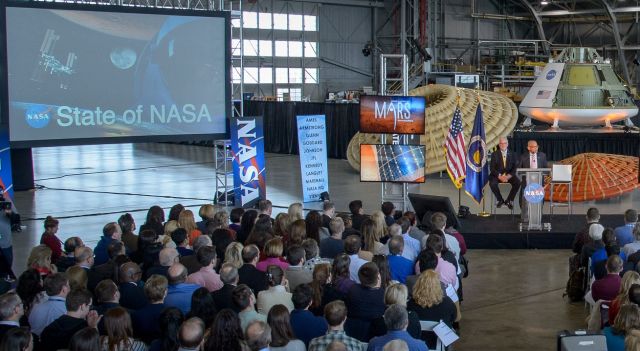
Each year President Obama submits a budget for NASA to Congress, and each year the House of Representatives and Senate essentially toss out those numbers and come up with their own figures. Now that the President has submitted a $19 billion NASA budget for fiscal year 2017, we can expect the same scenario to play out again this year.
The macro battle with Congress will likely remain over the direction of the space agency. NASA sees itself as being on a journey to Mars. On Tuesday Charlie Bolden, the agency’s administrator and a four-time astronaut, reiterated that point. “We are closer today than ever before in human history to sending humans to the red planet,” Bolden said during a State of NASA speech. “Our plan is clear, affordable, sustainable and attainable.”
However Congress has become increasingly skeptical about the viability of NASA’s plan to go to Mars. During a hearing earlier this month, Republicans openly questioned whether NASA was, in fact, on a path to Mars. The chairman of the House Science Committee, Rep. Lamar Smith (R-Tex.), called it an "imbalanced proposal [that] continues to tie our astronauts’ feet to the ground and makes a Mars mission all but impossible,” in a statement to Ars.The White House and Congress clearly have different visions about human exploration, and whether NASA should be spending more time and money on Earth science, or robotic exploration of other planets and moons in the solar system. As much as anything, Congress doesn’t seem to trust NASA and its administrator, appointed by the President. The new budget exacerbates this divide.
Rockets and spacecraft
In 2011 Congress directed NASA to build the Space Launch System (SLS) rocket, a large vehicle capable of delivering 70 metric tons of cargo to low-Earth orbit. The agency has since spent about $10 billion developing this rocket and associated ground systems, and it could be ready for an initial test flight by late 2018.
With every budget request since then, the President has asked for a certain amount of funding for the SLS rocket, and Congress has increased it. For example, in fiscal year 2016 the President asked for $1.30 billion, and Congress upped that to $2.0 billion. This year the President’s request calls for $1.31 billion, and Republicans in the House and Senate will almost certainly increase the rocket’s budget again.
The truth is, President Obama and the White House Office of Management and Budget have never been big believers in NASA’s need for a super-heavy rocket like the SLS right now. In 2010 Obama’s budget request killed NASA’s Constellation rocket program, which included a heavy lift vehicle. Congress fought back, however, and reinstated a new rocket program. Its design for the vehicle was so specific that some critics called the SLS the Senate Launch System. Congressional backers of the rocket said the nation needed a heavy lift launcher, but key legislators also may have supported the rocket because the program preserved thousands of jobs in key states and districts.
Although NASA is proceeding with development of the SLS, a number of outside panels have questioned whether NASA can afford to build, fly and, sustain the expensive program, especially with projections of low flight rates of one launch or fewer per year. The biggest concern is that the rocket is so expensive to fly it precludes a meaningful exploration program within NASA’s existing budget.
NASA’s latest budget request reflects some of this concern. In a teleconference with reporters, the agency’s chief financial officer David Radzanowski said the President’s budget request would allow the first crewed mission of the SLS rocket and Orion spacecraft to launch in 2023. However, he acknowledged, if Congress continued to add funding for the rocket, it could push up that crucial launch to as early as 2021.
So why isn’t NASA pushing for an earlier launch to get the SLS rocket program moving? Radzanowski didn’t really answer that question. The unstated answer seems to be that NASA doesn’t really need the SLS rocket developed that quickly, because it doesn’t have any significant human missions for it to fly because it cannot afford to build them.
Earth vs. Solar System
As they did during the 2016 budget cycle, the White House and Congress will likely clash again over funding for Earth science. The President won that battle last year, ultimately gaining a budget line of $1.92 billion for Earth science research, just $20 million less than his original request. Initial budget proposals from the House and Senate had slashed as much as $500 million from the President's request.
For the coming fiscal year the President wants even more funding, upping the Earth science budget to $2.03 billion. Much of the increase will go toward development of the Landsat 9 satellite, to expand the country’s Earth-observing capabilities.This won’t sit well with Congress. In his statement, Smith said, “The same time this proposal shrinks space exploration priorities within NASA’s budget, it disproportionately increases Earth Science accounts to more than $2 billion—a 70 percent increase since 2007.”
The underlying context here is climate change. The Republican-led Congress wants to see NASA, in addition to other federal agencies, spend significantly less on research that would almost certainly bolster the science that supports the theory of a warming planet. Congress would prefer to see those funds spent on planetary exploration, especially to the ocean worlds of the outer solar system, including Europa, Titan and Enceladus—all high priority targets for scientists.
To that end, last year, Congress provided $175 million for NASA to continue formulating a mission to Europa, calling on the agency to launch by 2022 or 2023. In this year’s budget request, however, the White House only asked for $49.6 million to develop the Europa mission, and didn’t anticipate launching before the late 2020s. Congress will undoubtedly have something to say about that.
reader comments
101